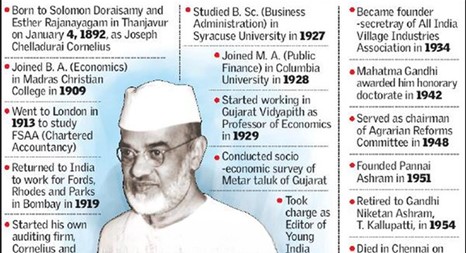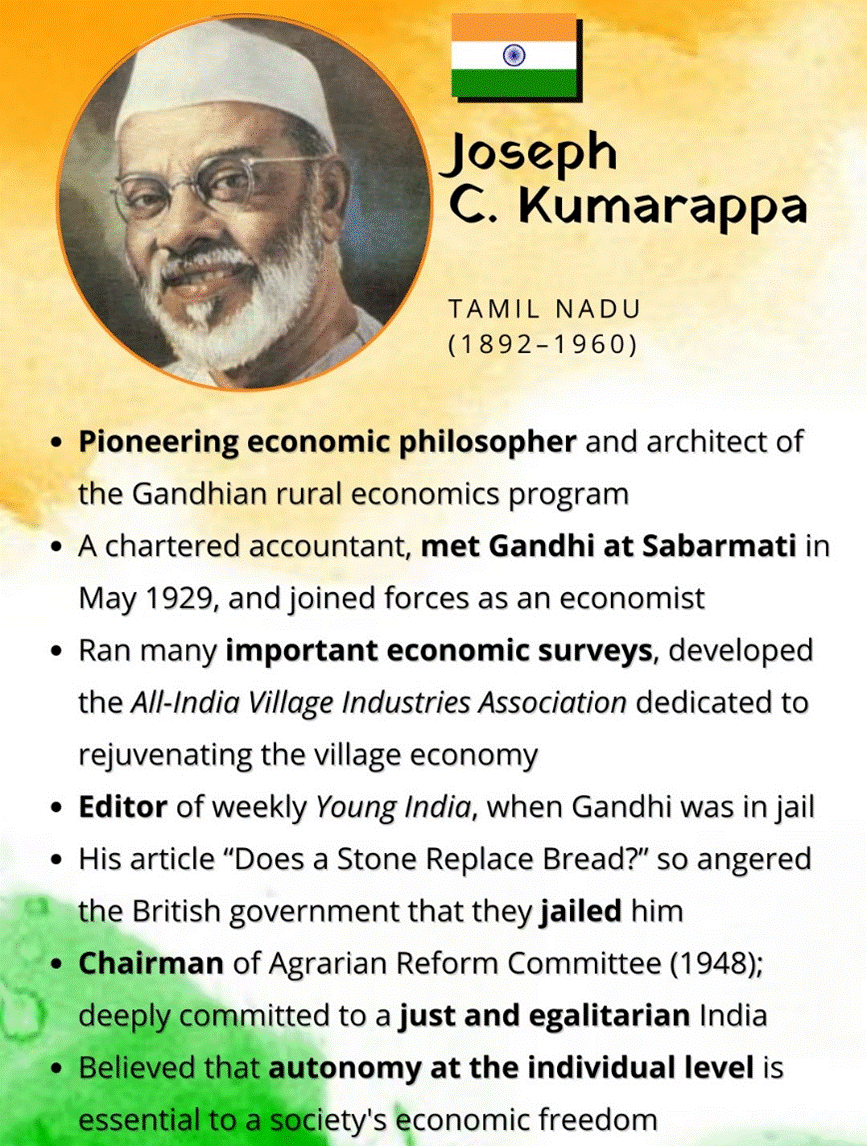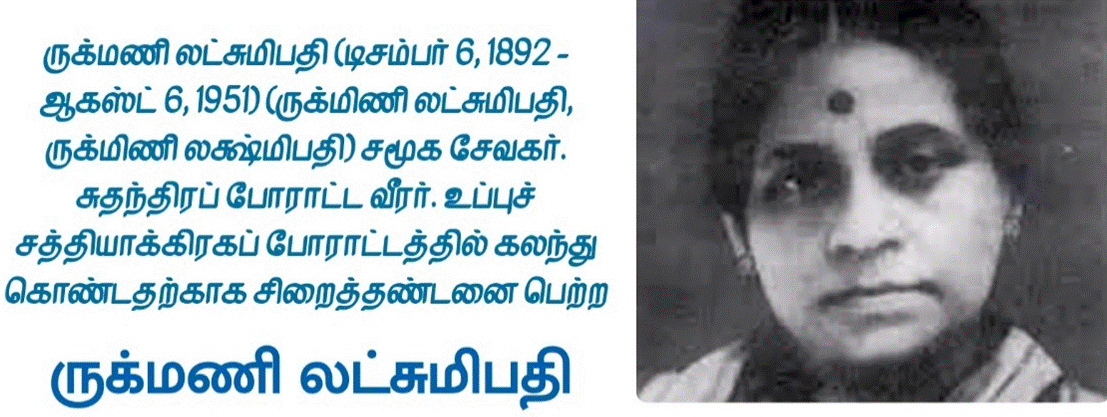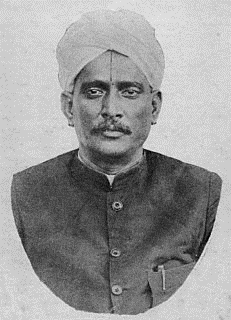PREVIOUS
Freedom Fighters from Tamil Nadu Part – 06
August 22 , 2024
244 days
4256
0
Freedom Fighters from Tamil Nadu Part – 06
(இதன் தமிழ் வடிவத்திற்கு இங்கே சொடுக்கவும்)
29. J.C. Kumarappa (The Green Gandhian)
Early Life and Education
- Dr. J.C. Kumarappa, born Joseph Chelladurai Cornelius on January 4, 1892, hailed from a devout Christian family in Tanjore, Tamil Nadu.
- He was the sixth child of Mr. Solomon Doraiswamy (an officer in the Public Works Department of the Government of Madras) and Mrs. Easther Rajanayagam (from a well-known family of poet Vedanayagam Sastriar).
- Kumarappa received his basic education in Madras and left for London in 1912 to pursue a Chartered Accountancy course.
- He continued to work for London banks and British auditors’ firms.
- Upon returning to India in 1919, he worked in Bombay with British firms and later set up his own firm of auditors, 'Cornelius & Davar.'
- He also served as Vice-Principal and part-time Professor at Davar’s College of Commerce.
Shift to Nationalism
- In 1928, Kumarappa went to the United States, earning a B.Sc. in Business Administration from Syracus.
- And an M.A. in Economics from Columbia University under Prof. Dr. Seligman.
- His thesis, "Public Finance and our (Indian) Poverty," transformed him from a European loyalist to a committed Indian nationalist.
- He returned to India in 1929 and sought to expose British exploitation of India through their taxation policy.
Meeting with Gandhi
- In 1929, Kumarappa met Gandhi at Sabarmati Ashram.
- Gandhi was impressed with his ideas and asked him to join his efforts in developing a new economic perspective.
- Kumarappa conducted a rural survey in Gujarat, resulting in the classic study, "A Survey of Matar Taluka in Kheda District."

Role in Freedom Movement
- Kumarappa became a significant figure in the Indian independence movement.
- He wrote for Gandhi’s journal, ‘Young India’, and faced imprisonment for his fiery writings.
- He had served on various committees, including the India National Congress’s financial obligations committee and the National Planning Committee.
- His economic surveys and writings greatly influenced nationalist economic thought.

Post-Independence Contributions
- After independence, Kumarappa focused on rural development.
- He was instrumental in forming the All-India Village Industries Association (AIVIA) and served as its secretary.
- He developed rural technologies and advocated for decentralised participatory planning.
- Despite health challenges, he continued his work, visiting Eastern Europe, the USSR, and China to study their economic systems.
Later Years and Legacy
- In his later years, Kumarappa lived in a Dalit village in Gujarat, promoting agrarian reform and sustainable development.
- His health deteriorated, and he spent his final years at Gandhi Niketan Ashram in T. Kallupatti (Madurai).
Notable Works
- Dr. Kumarappa authored several influential books, including:
- Economy of Permanence (1984)
- Why the Village Movement (1958)
- Cow in Our Economy (1963)
- Gandhian Economic Thought (1962)
- Swaraj for the Masses (1948)
- Europe Through Gandhian Eyes (1948)
- Peace and Prosperity (1948)
- Lessons from Europe (1954)
- An Economic Survey of Matar Taluka (1952)
- Present Economic Situation (1949)
- Public Finance and Our Poverty (1930)
- Swadeshi (1992)
- Grinding of Cereals (1947)
- Village Industries (1947)
- Clive to Keynes (1947)
- Christianity: Its Economy and Way of Life (1945)
- Economy of Permanence Part II (1948)
- The Gandhian Economy and Other Essays (1949)
- Stone Walls and Iron Bars (1949)
- Death: He passed away on January 30, 1960.
30. Rukmani Lakshmipathi
Early Life and Education
- Rukmani Lakshmipathi was born on December 6, 1892, into an agricultural family in Madurai.
- Her grandfather was a landlord, and her guardian was the Dewan of Cochin state.
- Rukmani graduated from Women’s Christian College, Madras, and was among the first batch of women to earn a B.A. degree from the institution.
- From a young age, she was imbued with the principles of nationalism, social justice, and the independence movement.
- Influenced by leaders like Mahatma Gandhi, Sarojini Naidu, and Rajagopalachari, she has actively participated in various freedom struggles and women's rights programs during her studies.
Inter-Caste Marriage
- Rukmani was a progressive thinker who set an example for society in many ways, including her personal life.
- She married Dr. Achanta Lakshmipathi, an MMC doctor who turned native Indian medicine practitioner and a freedom movement enthusiast.
- Their inter-caste marriage, which was uncommon at the time, created a significant impact.
- Together, they had two sons and four daughters, though their first son passed away at a young age.
- Following this, Rukmani devoted more of her life to the nation than to her family.
Political Participation
- Rukmani joined the Indian National Congress (INC) in 1923 at the age of 31 and played an active role in organizing the Youth League of the INC.
- She had been involved in social welfare activities well before joining Congress.
- In 1911, she participated in the women's movement and became the secretary of the Bharat Stree Mahamandal.
- In 1917, she joined the Women's India Association (WIA).
- Upon entering active politics in 1923, her first significant action was donating all her jewellery to the Harijan Welfare Fund, a heroic act for a woman of her time.
- As an Indian representative, Rukmani attended the International Women's Suffrage Congress in Paris in 1926.
- She had actively participated in movements related to Khadi, abolition of child marriage, and liquor prohibition, and she taught others to spin and wear Khadi.
- Rukmani opposed the Simon Commission vehemently and celebrated a hypothetical Independence Day on January 26, 1930, by raising the tricolor flag in Triplicane or Thiruvallikeni in Chennai.
Imprisonment for Salt Satyagraha
- Gandhi's principle of Satyagraha attracted many women to the freedom struggle.
- Under the Civil Disobedience Movement, Gandhi began his march to Dandi on March 12, 1930, to break the Salt Law.
- Concurrently, under Rajagopalachari's leadership, a similar march took place in Tamil Nadu from Tiruchirappalli to Vedaranyam.
- Rukmani was among the 100 Satyagrahis chosen for the Salt Satyagraha in Tamil Nadu.
- On May 15, 1930, she picked a handful of salt from Vedaranyam and was arrested, becoming the first woman to be arrested for the Salt Satyagraha and the Civil Disobedience Movement throughout India.
- She was the first woman to pay penalty for violation of salt laws.
- She was imprisoned for a year in Vellore prison, where 30 of her letters were preserved at the Nehru Memorial Museum and Library.

Legislative Achievements
- In 1934, she was elected to the Madras Legislative Council.
- She had served as the Vice President of the Tamil Nadu Congress Committee and was elected Municipal Councilor in 1935-36.
- In 1937, she became the first woman member of the Madras Presidency Legislative Assembly and was later elected as Deputy Speaker from 1937 to 1945.
- In 1941, Gandhi handpicked her as one of the 21 Satyagrahis for the Individual Satyagraha Movement.
- She was arrested again and stripped of her representative posts.
- After World War II, under the Congress Ministry, T. Prakasam became the Chief Minister of Madras Presidency in 1946, and Rukmani served as the Minister of Public Health from May 1946 to March 1947.
- She also served local bodies like the Madras Corporation and the Chingelpet District Board and was an Honorary Presidency Magistrate in Madras.
Demise
- After a long struggle for independence, Rukmani hoisted the national flag at the Congress Office in Royapettah to mark Independence Day.
- She continued as an MLA in independent India until her death on August 6, 1951.
- In her honor, a road in Egmore, Chennai, was renamed after her, and in 1997, the Government of India issued a postage stamp in her memory.
31. P. Rangaiah Naidu
Early Life
- Palavai Rangaiah Naidu was born in 1828 in a Telugu-speaking family in the Madras Presidency.
- He graduated in law and set up a successful practice as a lawyer.
- He was soon nominated to the Madras High Court.
Involvement in Independence Movement
- Rangaiah Naidu was an active leader in the Indian independence movement.
- He was a key figure in the early stages of the Indian National Congress and participated in its first session in Bombay in December 1885.
- He was also a significant leader of the Madras Mahajana Sabha, serving as its first President when it was founded in 1884.
Contributions to Politics
- Rangaiah Naidu served as a member of the Madras Legislative Council from 1892 to 1899.
- He had played a vital role in advocating for self-rule and greater representation for Indians in government.
- Additionally, he was a trustee for Pachaiyappa's College, Chennai, from 1883 to 1902.
Later Life and Death
- Rangaiah Naidu passed away in 1902 in Egmore.
- In recognition of his contributions, two streets in Egmore were named after him and his father, Veerasamy Naidu.

-------------------------------------
Leave a Reply
Your Comment is awaiting moderation.


